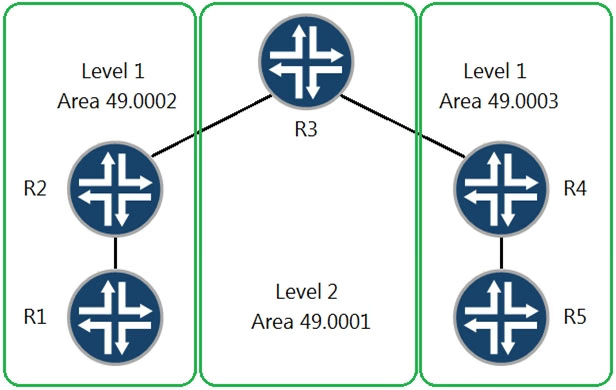
All adjacencies have been formed, no extra options have been configured, and no policies have been written.
Referring to the exhibit, which two statements are correct? (Choose two.)

All adjacencies have been formed, no extra options have been configured, and no policies have been written.
Referring to the exhibit, which two statements are correct? (Choose two.)
In the given topology, R1 is a Level 1 router in Area 49.0002, and hence it cannot directly reach the Level 1 routers in Area 49.0003 (R4 and R5) across the Level 2 backbone (Area 49.0001). R1 cannot inherently reach R5 without a Level 2 router intervening. Hence, R1 itself will create its own default route that points to R2 because R2 is the L1/L2 router and will propagate a default route to R1.
CD. R1 sees attach bit in Level1 LSP and it installs default route in routing table. Also i dont see any reason why R1 cant reach R5
https://www.juniper.net/documentation/us/en/software/junos/is-is/topics/concept/is-is-routing-overview.html#routing-is-is-overview__d8374e173 L1 router installs it is correct
R1 will create it's own default route
https://www.juniper.net/documentation/us/en/software/junos/is-is/topics/example/logical-systems-isis-policy-default-route.html
CD is correct
cd is correct
CD, as a L1 chooses the best TLV with attachted bit set as the next hop for the default
Juniperguy and somanyquestions are totally correct.
CD is correct
C and D are correct
https://www.juniper.net/documentation/us/en/software/junos/is-is/topics/concept/is-is-routing-overview.html#routing-is-is-overview__d8374e173
CD ia correct
C and D are correct: The R2 is a L1/L2 router and because of that it sets the attached bit in the Level 1 PDUs and the R1 Router (L1) generates its own default route that points to R2. As a result R1 reaches R5 router and another routers out of L1 area.